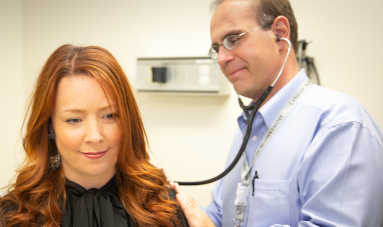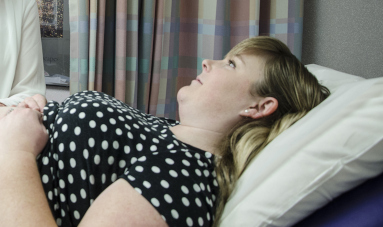
You’re more tired than usual, your ankles are may be swollen, your back may ache. The last thing you may feel like doing while pregnant is exercising. But working out can actually help ease certain pregnancy side effects and benefit you and your baby in other ways.
Studies have shown that regular, moderate exercise during pregnancy may help you:
- Control weight gain
- Ease backaches, constipation and swelling
- Reduce the risk of gestational diabetes and preeclampsia (high blood pressure)
- Improve sleep
- Boost your mood
- Shorten labor
- Reduce the risk of having a C-section
- Make it easier to recover after baby is born
What about baby? Exercise during pregnancy can support baby's development. A 2019 study found that babies born to moms who exercised at least 150 minutes a week had developed more advanced neuromotor skills (body movement) by one month of age.
The American College of Obstetricians and Gynecologists (ACOG) suggests that expecting moms get at least 30 minutes of moderate exercise at least five days a week. You don’t have to do 30 minutes straight—you can sprinkle it throughout the day, such as three 10-minute walks. Even activities such as vacuuming, light yard work, or taking the stairs instead of the elevator can count toward your daily goal.
Most women with healthy pregnancies can exercise safely, without an increased risk of miscarriage or early labor. However, if your pregnancy is high risk due to conditions such as high blood pressure, diabetes, problems with the placenta or if you're having twins or more, your doctor or midwife might suggest avoiding certain types of exercise.
Talk with your OB/GYN or midwife during your first prenatal care visit about what kinds of activities and how much exercise may be safe for you. To get started, consider this list of some of our patients' favorite pregnancy-safe exercises.

5 pregnancy-safe exercise ideas
For most women, these activities are generally safe during pregnancy:
- Walking/light jogging: If you’re new to exercising, walking is a great way to start. A brisk walk will get your heart pumping while also being easy on your joints and muscles.
- Swimming or water walking: Water helps support the weight of your growing belly. Water exercises often are gentler on your joints and muscles—a great option if you have lower back pain doing other activities.
- Modified yoga and Pilates: These low-impact workouts can improve flexibility and reduce stress. Let your instructor know you’re pregnant so they can help you modify or avoid poses that require lying on your belly or flat on your back. Some centers offer specialized prenatal yoga classes. Avoid sit-ups or planks.
- Riding a stationary bike: Cycling is generally easy on the joints. Because your growing belly can affect your balance, you’re less likely to fall off of a stationary bike.
- Strength training: These exercises help you build strong muscles and bones. Ask your doctor how much weight you can safely lift throughout your pregnancy.
If you ran, swam, or played sports before becoming pregnant, talk with your provider about whether you can continue and for how long. I usually recommend moderate exercise, intended to increase your heart rate. Make sure you are able to carry on a conversation or sing along to a song to ensure you are not going into an anaerobic phase, which requires more oxygen.
Make sure you drink lots of water, and when it’s hot and humid, consider doing something in an air-conditioned space instead of outside. I know it can be hard to find time to exercise, especially when you have other little ones around. When possible, include them. You’re never too young to start a healthy exercise routine!
Exercises to avoid during pregnancy
While many activities are perfectly safe for pregnant women, there are a few you should avoid.
Stay away from sports that put you at risk of getting hit in the abdomen, such as soccer or basketball. Also avoid activities that might lead to falling, such as horseback riding, skiing, or skating. You’ll also want to skip hot yoga, particularly in the first trimester, due to an increased risk of birth defects related to excessive heat exposure.
Avoid abdominal core work, like sit-ups, or planks, especially if you notice a separation or diastasis of your abdominal muscles.
Maintaining your abdominal strength while you’re expecting can help support your pelvic organs and relieve pressure on your back. But your baby bump can make abdominal exercises difficult, especially since many require you to lie on your back. You can modify many of them by propping yourself up on a ball or wedge pillow, standing upright, lying on your side, or getting on all fours.

Listen to your body
As your belly gets bigger, you may need to change some activities or ease up on your workouts. Your center of gravity will shift, making balance a bit tricky. Also, pregnancy hormones cause your joints to loosen, which can increase your risk of injury.
It’s important to listen to your body. If something doesn’t feel right while exercising, stop. If the feeling or pain doesn’t go away, check with your OB/GYN or midwife. Watch for signs of a problem, such as:
- Blood or fluid leaking from your vagina
- Chest pain
- Feeling dizzy or faint
- Leg pain or swelling
- Painful uterine contractions
If you experience any of these symptoms, stop your routine and call your health care provider.
Exercising regularly during pregnancy can help improve your health and the health of your baby. If you didn’t exercise before you were pregnant, now is the perfect time to start. Build up your fitness bit by bit and remember—we’re here to help.
After pregnancy, it is important to work hard to rebuild your core strength and pelvic floor. Look for exercises on improving diastasis and start Kegel exercises immediately.
Schedule an Appointment
Schedule a time to discuss exercise options with your OB/GYN provider. Call 505-272-2245 today.

